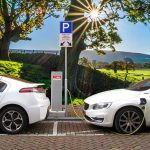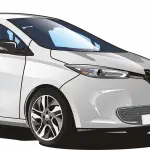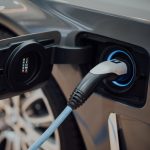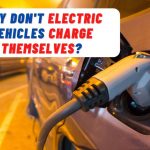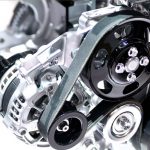Last Updated on August 24, 2022 by
The use of electric vehicles such as e-bikes, e-scooters, and e-cars has been steadily gaining momentum in the past decade. The most prevalent reason for this change is the benefits it brings to the environment.
The internal combustion engine in traditional vehicles emits toxic pollutants causing harm to the environment and also bringing about diseases in humans like heart problems, cancer, and asthma.
On the other hand, electric vehicles run on electricity releasing zero emissions and thereby contributing to a healthy environment.
Along with environmental benefits, electric vehicles offer economic benefits as well. For example, electric vehicles operate on electric charging which costs less compared to fueled vehicles which run on gas or petrol.
All these benefits are driving people to transition from fueled vehicles to electric vehicles at a much faster rate.
That said, many often ask the question “Do electric vehicles have brakes?”. The simple answer is YES.
Whether it is an e-scooter, an e-bike, an electric car, or any other electric vehicle, all e-vehicles have brakes.
For example, electric cars come with both a brake pedal and a “one-driving” pedal which also helps in slowing the car. Similarly, an electric scooter comes with both mechanical and electric brakes.
Let’s further dig deep into the braking system of electric vehicles through some questions.
Do Electric Cars Have Hydraulic Brakes?
It is a known fact that traditional gas-powered cars come with hydraulic brakes.
When a driver steps on the brake pedal, hydraulic fluids bring the brake pads and discs together causing friction that helps in slowing the car. This is how a hydraulic braking system works in a gas-powered car.
In electric cars along with hydraulic brakes, there is one extra braking system called regenerative braking.
Now the question is why the need for hydraulic brakes if there is already a regenerative braking system.
The regenerative braking system can’t stop a car as fast as a hydraulic braking system does. If there is any emergency, hydraulic brakes are a great asset to have.
Overall, electric vehicles have a mix of both electric and hydraulic braking systems.
Which Cars Have One-Pedal Driving?
Electric cars come with a wide range of amazing EV features and one among them is the one-pedal driving feature.
The one-pedal driving is available on selected electric cars only. It is a single pedal used both for speeding and slowing the car.
With such a feature, the driver doesn’t need to switch between pedals for acceleration and brakes which is commonly carried out when using traditional cars. Having such a feature makes driving easier.
Unfortunately, not all electric cars have this feature. Some cars that boast one-pedal driving include vehicle models like:
- Audi e Tron
- Nissan Leaf
- Tesla
- Polestar
- Kia Niro
- Hyundai Kona EV
- Kia EV6
- Volvo XC40
One-Pedal Driving In Electric Cars – How Does It Work?
One-pedal driving is one of the amazing features of an EV car. When the one-pedal driving feature is activated in an electric car, the gas pedal can be used both for accelerating and slowing the car.
There are many benefits that come with the one-pedal driving feature. One of them is, that it helps in extending the battery life of the car.
EV car’s one-pedal driving feature captures the kinetic energy when braking or accelerating and converts it into electricity. It then uses this to charge the battery of the car.
This is how the “one-pedal driving” feature helps in extending the battery life of a car. In contradiction to “one-pedal driving”, in a normal braking system, the system converts the kinetic energy into heat and then releases it into the air.
Here is a brief breakdown of how the one-pedal driving feature works.
Most EV cars have an on and off button to activate the one-pedal driving system. At a traffic signal, the driver should slowly release the foot from the gas pedal which gradually slows the car down.
Once the car completely halts, the hydraulic brakes come into action keeping the car at a halt. Soon when the driver accelerates the pedal, the car starts moving.
All the time while using one-pedal driving, the brake lights get illuminated. Once the foot is off the accelerator pedal, the brake lights start flashing giving a signal to the drivers behind, that the car is slowing.
Does Regenerative Braking Use Brake Pads?
The general idea of a regenerative braking system is to convert some kinetic energy into electricity and use it to power the battery. But brake pads convert kinetic energy into heat.
This is why regenerative braking doesn’t make use of brake pads. With them, it is not possible to use the energy to charge the battery.
How Does Regenerative Braking Work?
All electric cars have an electric motor in them. The electric motor has dual functionality.
One functionality is to move the car and the other is to recharge the battery. When the foot is released from the accelerator pedal, the regenerative system transforms the electric motor into a generator which converts the kinetic energy into electricity and powers the car’s battery.
As this happens, the driver can feel that the car is gradually slowing down. The sensation of the braking system is different in different car models.
Which Cars Have Regenerative Braking System?
Presently, all EV cars make use of the regenerative braking system. Here is a list of a few cars that use this feature.
- Tesla Roadster
- Hyundai Kona Electric
- Nissan Leaf
- Audi e-Tron
- The Chevy Bolt
Ford One-Pedal Driving
Ford’s Mustang Mach-E comes with one-pedal driving which allows controlling the car speed with just the accelerator pedal. To speed and slow the car, the accelerator pedal does both jobs.
There is no requirement of using the brake pedal.
Instead of using the brake pedal, letting the foot off from the accelerator slows the car down. The one-pedal driving feature is perfect to use in stop-and-go traffic settings.
Below are the steps to activate the one-pedal driving feature in Ford Mustang Mach-E.
- On the touch screen, in the upper-left corner, click on the Mustang Mach-E icon.
- Next, from the Drive Mode screen, the one-pedal driving feature can be activated.
Since it doesn’t turn off automatically, the feature has to be turned off manually. If failed to do so, once the car is started, the one-pedal driving feature remains in active mode.
FAQs Relating To Electric Vehicle Brakes
Here is a list of some most common questions related to the braking system of electric vehicles.
Do Tesla Cars Have a Brake Pedal?
Tesla cars actually have two pedals. These include the brake and the accelerator pedal.
The accelerator pedal acts as a “one-pedal driving system”. This means the driver can slow down the car without touching the brake.
Gently taking the foot off the accelerator pedal in Tesla results in the slowing of the car. But to completely halt the car, the use of a brake pedal is necessary.
Do Electric Cars Have Power Brakes In Them?
Yes, electric cars have power brakes in them.
The power brakes in EV cars work just like a generator. It helps in charging the battery of the car.
What Kind Of Brakes Are Available In Electric Cars?
Electric cars come with three braking systems. Two of them are similar to the ones used in internal combustion cars.
The first braking system is the parking brake. It is on the rear wheels of electric cars and can be operated electrically or mechanically.
The second braking system is the hydraulic brakes.
The hydraulic brakes are present on all four wheels and are operated using the brake pedal. The advantage of having such brakes is that they exert maximum pressure to stop the car.
The third one is the regenerative braking system. When gently taking the foot off the accelerator pedal, the regenerative braking system comes into play.
This braking system turns the electric motor of the vehicle into a generator which helps in charging the battery. In doing so, it causes a magnetic resistance in the motor that forces the car to slow down.
When the regenerative braking system kicks in, the braking lights turn on. These lights give an indication to the drivers behind the car, that the car has applied brakes.
Do Electric Cars Come With Engine Braking?
No, electric cars do not come with engine braking.
Broadly speaking, the engine brake helps in slowing the car with the help of the gearbox. However, electric cars don’t have a gearbox, therefore there is no need for an engine brake system.
Do All Electric Cars Have a One-Pedal Driving System?
Unfortunately, only some electric cars come with a one-pedal driving system feature. This feature allows the drivers to use the accelerator or gas pedal to speed and slow the car.
Some popular car brands like Volvo, BMW, Ford General Motors, Hyundai, Nissan, and Mercedes to name a few have EV cars that include a one-pedal driving system.
Do Electric Brakes Work When The Battery Is Down?
All electric cars come with electric brakes which run on electricity. If the battery dies, the car switches from electric brakes to the hydraulic braking system which results in stopping the car.
- Why Electric Vehicles Are Not Popular - January 29, 2023
- How Long Do Tesla Batteries Last Per Day? Battery Facts - January 25, 2023
- Do Electric Vehicles Have Air Conditioning? - December 21, 2022

